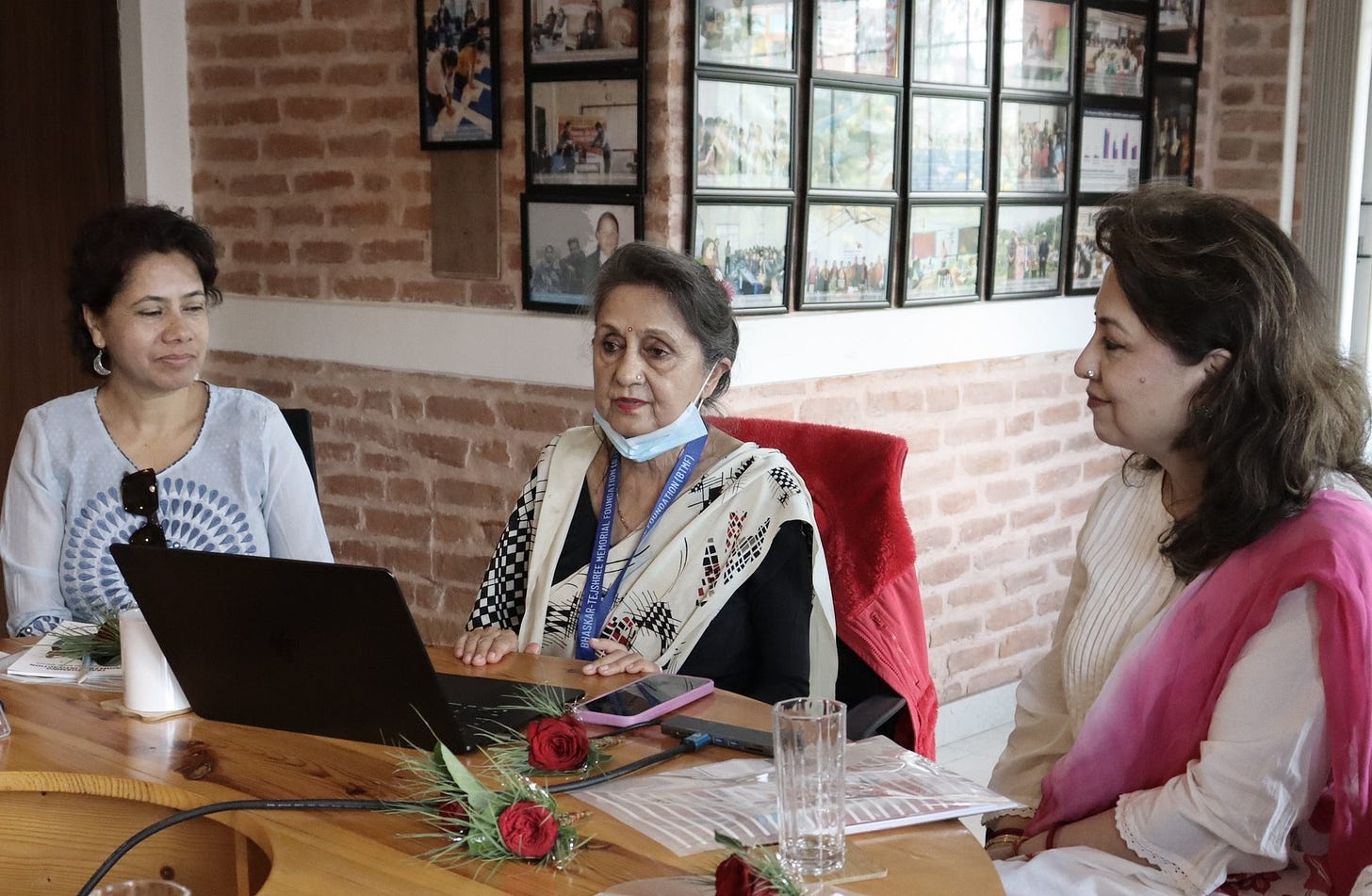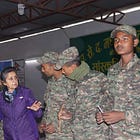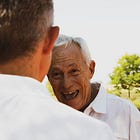How Nepal made mothers the backbone of its health system
An interview with Prof. Dr. Rita Thapa

Lire cet entretien en français:
Prof. Dr. Rita Thapa is a renowned Nepalese public health leader, widely recognised as the visionary behind the country’s maternal, child and primary health care framework. A relentless advocate for reproductive rights and women’s empowerment, her programme of female community health volunteers (FCHVs) was and remains the backbone of Nepal’s health system.
Today, as the founder and executive director of the Bhaskar-Tejshree Memorial Foundation, she leads the implementation of interactive educational programmes in schools aimed at preventing high-risk behaviours such as alcohol, tobacco and carcinogenous food consumption, as well as gender-based discrimination and sexual harassment.
In this interview for The Fifth Wave Institute, Dr. Thapa reflects on her six decades of transformative work in maternal, child and community health. We discuss the integration of family planning with maternal and child health, the struggle that led to the legalisation of abortion in 2002, and how one mother’s care inspired the entire FCHV programme – all of which have made Nepal a global model in reducing maternal mortality.
This interview is the third in our inaugural series on perinatal care. You can read the first two here and here.
What led you to work in maternal and child health?
What I saw in Nepal’s first maternity hospital in the 1960s. Women coming in with repeated unwanted pregnancies, suffering complications from dangerously performed clandestine abortions. Women feeling helpless and powerless, unable to make their own reproductive choices.
I had just come out of med school, and I naively asked one woman, ‘Why do you always want to get pregnant?’. She paused, and replied: ‘Doctor, we are not like you. We have to do whatever our husband wants.’ I knew that if those women were given access to even the most minimal family planning services, much pain and many deaths could be prevented.
That’s why in 1964, despite my supervisor’s warning that public health had “neither money nor glamour”, I became the head of Nepal’s first ‘Maternal and Child Health and Family Planning’ programme. It was hard: we had to start from scratch, and very few people involved had any meaningful experience. I had to fight the male representative of a foreign donor agency to carry out my vision of integrating the MCH and FP components into a single department. But I’m tremendously proud of all the change that first programme initiated.
You pioneered the creation of a now-celebrated Female Community Health Volunteers programme. How did you go about it?
Once the MCH-FP department was well-established, which strengthened the evidence base in favour of de-siloing health systems, I went on to lead the national integrated primary health care project. This was a key priority in the Nepalese government’s first long-term health plan (1975-1990), sparked by a worrying resurgence of malaria and other communicable diseases, as well as alarmingly high maternal and child mortality. My mandate was to unify five vertical programs – maternal and child health, smallpox, malaria, TB, and leprosy – under one administrative umbrella, to deliver an integrated package of basic health care.
It felt like another ‘Mission Impossible’. Once again, the heads of all five vertical programs were united in opposing the integrated approach. But I soldiered on, and managed to unify thousands of community-based health workers from the five verticals, allocating one to each village to guarantee comprehensive coverage. However, we soon realised a single ‘village health worker’ could not deliver the full package of basic health services across all priority areas. This signaled an imminent crisis: failure to show results would mean losing the hard-won gains of the entire project.
Then, my mind flashed back to a scene I’d witnessed back in 1968. I was in a village in Ilam establishing a new MCH-FP clinic for the area. A desperate mother came in at midnight with her severely dehydrated, listless baby. I had nothing on hand to help her, the clinic hadn’t been furnished yet. But as a doctor, I had to do something.
Though I had little hope this would work, I hurriedly taught her how to make a homemade oral rehydration solution using boiled water, sugar and salt, and told her to feed it to her baby while intermittently breastfeeding. Importantly, this went against the folk knowledge in the villages that forbade people from giving fluids to children who suffered from diarrhea – the leading cause of death among children in those years. I went to bed with a lingering fear that the little girl wouldn’t make it.
The mother and child stayed in a room next to mine. At around five in the morning, I opened the door… only to see the child happily playing and cooing on her mother’s lap. It felt like a miracle. It was a vivid manifestation of what Professor Carl Taylor had taught me at Johns Hopkins: mothers are frontline caregivers. Not only had that woman been willing to trust me against popular advice, but she’d competently done what it took to save her child with a few kitchen ingredients. And maybe she could be relied on to pass that knowledge to others.
We therefore decided to leverage local married women’s community leadership and caregiving skills by training one “community health leader” (CHL) per village. These women would take on the bulk of health education and preventive work at the community level: delivering contraceptives, setting up immunisation outreach clinics, teaching homemade oral rehydration techniques, and promoting clean birthing practices to avoid infection.
They were also responsible for referring cases of illness to the relevant local integrated health post. That way, medical staff could focus on providing clinical services, while we ensured that our CHLs reached every locale in their perimeter.
The concept was strong, but it had to be backed by solid scientific evidence to survive the political challenges ahead.
In 1978, we piloted a CHL training program. We designed a job description and training manual, using a staggered model of an initial 12-day session followed by one day per month of both additional training and reporting at the local health post over the remainder of the year. The women received compensation for each day’s wage lost – about 50 rupees or $4 at the time.
The evaluation showed significant improvements to service delivery: the CHLs were performing as expected. Encouraged by the positive feedback, I submitted a proposal to the ministry of health, asking for funding to train one CHL per health post in the country. I heard nothing for a month. I approached the health secretary, and he said to me: “I thought you were an intelligent woman, but now you want to place a leader in every village. How many leaders do you need in such a small country, Dr. Thapa, isn’t one enough?”
I understood the political undertones. In my enthusiasm, I’d almost forgotten Nepal was then under an absolute monarchy. Leaders in every village sounded like an uprising in the making. I withdrew my proposal and re-labelled CHLs ‘female community health volunteers’.
I liked the original name, it was a way for us to pay tribute to women’s enduring leadership in their communities. But what’s in a name? A rose is a rose, and that leadership endures, whether recognised by the authorities or not. I returned to the health secretary and got immediate approval.
That’s how the program began, out of necessity, with grit. I never imagined it would grow into 50.000 volunteers, recently recognised as the WHO South-East Asia Public Health Champions. It is profoundly rewarding.
Nepal’s FCHVs each lead a monthly “Mothers’ Group” to share health information and coordinate prevention efforts. What is the history of these groups?
The Mother’s Groups emerged out of centuries of patriarchal oppression in Nepal. They first started as informal village groups, gathering to discuss how to improve local women’s lives by tackling deep-rooted problems, such as men’s alcohol abuse and associated violence. Today, they are well-structured national-level advocacy groups, working on maternal health and domestic abuse but also agriculture, microfinance, and peacebuilding. I remember reaching out to them for support in identifying and recruiting motivated mothers as FCHVs. They are truly vital sites of change in the country. Honestly, they should form a political party.
Nepal legalised abortion in 20021, while neighbouring countries like Sri Lanka, Pakistan or Bhutan still broadly restrict it to life-threatening cases. What explains this outlier status?
Three factors: activism, public health research, and democratisation.
Debates around abortion were already brewing when I first joined the medical field, largely thanks to the work of women’s rights activists. It was a dangerous fight: even before the Panchayat era2, activists were being jailed for campaigning in favour of girls’ schooling, and women were imprisoned with draconian sentences for soliciting abortions – many of whom had gotten pregnant following rape.
Several large-scale studies then made it impossible to ignore the extent of the public health emergency. One showed that as many as 50% of maternal deaths in hospitals were due to abortion-related complications; several others that one-fifth of women in Nepalese prisons had been convicted of performing or receiving abortions.
The end of the Panchayat era further opened the doors to change. Newfound media freedom allowed a variety of television channels and newspapers to spread information about women’s rights and abortion to the public. After much legislative reticence, the government passed the Muluki Ain3 11th Amendment Bill, which enshrined the right to terminate a pregnancy of up to 12 weeks, or 18 weeks in the case of rape or incest.
Thousands of women were released from prison. It was a historic milestone. Together with the broader advances in maternal healthcare, the legalisation of abortion further contributed to the sharp decline in maternal mortality. For reference, there were about 1500 deaths per 100,000 live births during the 70s, and by 2000 that had dropped to less than 500. In 2023, the ratio was down to 142 – a 70% drop in under twenty-five years. It’s still too many, but we’ve come a long way.
You founded the Bhaskar-Tejshree Memorial Foundation, named after your son Bhaskar Thapa, a geological engineer, and your daughter Tejshree Thapa, a renowned human rights advocate who helped establish wartime rape as a crime against humanity. What does it focus on?
The foundation was born out of our unbearable grief. We lost two of our precious children in the prime of their years. Bhaskar was such a thoughtful young man, whom we lost to a heart attack. And Tejshree… She was a different character. She took everybody’s pain as her own pain. We pledged to do our best to protect other families from suffering the loss we did.
As in many other places, heart disease is now the number one cause of death in Nepal, followed by other non-communicable diseases (NCDs) like cancer, kidney failure or diabetes. For a long time, many Global South countries battled tirelessly against communicable diseases like malaria; much of that fight has now shifted to NCDs. We know that about 80% of NCDs are preventable through better lifestyle habits. Things like junk food, sugary drinks, tobacco, alcohol, physical inactivity and stress are huge problems in Nepal that can’t be addressed by building more hospitals. We wanted to focus on prevention.
Over the last decade, we’ve developed and implemented two flagship initiatives for experiential school-based prevention: one focused on heart disease (dedicated to Bhaskar), the other on raising awareness of sexual harassment and gendered discrimination (in memory of Tejshree). Both are designed to help adolescents question the attitudes and consumption patterns that carry the greatest physical and mental health risks, at a period in their lives where they haven’t yet cemented those harmful habits.
Both programmes are now a part of school curricula across all provinces of Nepal. It heartens me to think that even when I’m gone, we’ll have helped some of these young men and women to grow into more conscientious, kind, thoughtful adults.
Any other words of wisdom for public health leaders everywhere?
One, reach every doorstep. Always focus on the most vulnerable, underserved groups of population. They may be in the cities, they may be in the countryside. But try to reach them.
Two, practice what we know works. We have so much proven knowledge by now, we know community-based health works – yet there is a reluctance to empower communities to be better informed and take charge of their own healthcare, even for low-technicity tasks that don’t require extensive training. People have a deep capacity for caregiving when they’re well-supported: we need institutions to understand and mobilise that.
Some of the richest countries in the world are withdrawing funds from rural health, letting small-scale birthing homes close down, and encouraging the further centralisation of care provision. Nepal has far fewer resources, but we’re managing to reach almost everyone by tapping into the energy and creativity of the women in our communities. That takes a particular kind of political will.
And finally, as I always like to ask: Who do you care for, and who cares for you?
I’m blessed to be a part of a deeply caring family, which includes my husband and our remaining daughter. I cherish them every moment. My daughter-in-law and grandchildren also care for me. And in a different way, I always feel invigorated and hopeful when meeting people like you who are taking this work forward!
Further reading:
While legal in theory, abortion was in practice restricted to approved sites and providers, and women could still be imprisoned for seeking an abortion outside these bounds. It was gradually expanded over the years, and in 2021 Nepal’s government moved to fully decriminalise abortion – though proper implementation is still subject to debate.
The system in place from 1961 to 1990 which banned political parties and placed all executive power in the hands of the king.
Nepal’s civil code.



